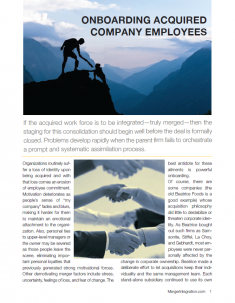In a merger, acquisition, or takeover, reductions may be required immediately after the announcement of the transaction, or they may be required after work is transitioned from a department. In either case, you should prepare for the following necessary actions:
-
Review Department Functions and Determine Staffing Requirements
This requires an evaluation of major tasks performed within a department and the labor hours required to accomplish those tasks. The due diligence review of all departments should have provided historical data from the organization to facilitate the staffing decisions, whether those are based on transaction numbers, dollar volumes, number of accounts, number of employees, or other quantitative factors. In this process, it is important to consider the tasks, not the individuals assigned to the tasks. The end result should produce the staffing projections for the combined organization.
When calculating staffing projections, it may be helpful to use required work standards and management ratios.
-
Identify Individuals Who Will Be Reduced
In some cases, an entire department will be closed and there is little selecting or deselecting to do. Perhaps one or two members of the management team or the most experienced and knowledgeable team members would be asked to join the acquiring company.
-
If, because of geographic location, it is possible to transfer a large number of the sending employees to the receiving department, it may be necessary to go through a selection process. We recommend selecting individuals based first on position function, second on performance, and third on tenure (assuming a non-union environment). When reviewing performance, you should consider the most recent and prior performance evaluations as well as any documented performance problems that have occurred over the prior year. If there is no previous documentation of performance, each employee should be rated on current performance factors.
-
Review for Adverse Impact
When individuals have been identified for separation, human resources should review the selected candidates along with the retained employees for adverse impact. This is to prevent the occurrence of a discriminatory trend against any group based on age, sex, race, color, national origin, or religion.
The EEOC provides a guideline of four-fifths, or 80%, to determine adverse impact; that is, a selection rate for any race, sex, or ethic group that is less than four-fifths of the group with the highest rate of selection may be considered evidence of adverse impact. This is not necessarily binding in courts, and the size of the workforce and the size of the protected classes can greatly challenge the statistical calculation, but this is offered as a rule of thumb. We recommend you engage legal counsel when finalizing any lists for separation actions.
-
Determine If the WARN Act Applies
The WARN Act requires employers with 100 or more workers to provide at least 60 days notice of a plant closing or mass layoff to affected workers or their representatives, state-dislocated worker units, and the appropriate local government. A reduction in force is considered a mass layoff when a company terminates 50 employees who represent 33% of the workforce at a specific location. The layoffs considered in this calculation roll back to include reductions conducted within the previous 90 days at that location. Therefore, you must be aware of any layoffs that have already occurred within the sending as well as the receiving company.
Note: In situations where the WARN requirements are in play and an employee chooses to leave during the 60-day notice period, no severance would be paid.
-
Determine Level of Severance Pay and Outplacement, If Any
Severance pay and outplacement may not legally be required, but there may be a written company policy that dictates such practices during reductions in force. Certainly, being consistent with prior actions is important, but there are two other reasons to consider such benefits to employees affected by a reduction. One is to soften the financial and emotional blow for separated employees. The other is to soften the emotional blow to retained employees. Although they do have jobs, their coworkers and good friends may be affected, so the company’s treatment of those individuals does impact the morale of retained workers.
The questions to pose are “What has been the past practice?” and “What can we afford?” balanced with “What impact are we having on the community?” and “What opportunities exist for expedient reemployment for the separated workers?” In other words, the local labor market and the skill level of the workers may play a role in the decision. If unemployment is low and skill levels are high, the pressure to provide severance and outplacement is certainly relieved, compared to a situation with high unemployment and low skill levels.
There can also be enhancements built into a basic plan to encourage certain outcomes—for example, release agreements and executive noncompete considerations.
For outplacement options, you may want to consider those companies that provide services ranging from resume preparation to full executive outplacement packages including career counseling, job search, talent assessment, office facilities, and clerical assistance. Also, check with the local unemployment office to see what services are offered to help employees prepare for a job search. These types of activities help dislocated workers focus on the future and work through the process of dealing with job loss.
One additional consideration regarding the severance package is whether any customary employment benefits will be extended. For example, will medical coverage be continued through the period of severance? Some employers choose to stop all benefits as of the last day of active employment, with COBRA options in effect immediately. In other situations, some benefits may remain in place during the severance period. If COBRA options are in effect, the employers may elect to continue to pay the company contribution portion during severance. Several factors may be considered here. You should contact the insurance providers to determine what limitations your carriers may have; plus you may want to contact your state unemployment office as this can impact unemployment eligibility dates that vary by state.
-
Create Reduction Communication Documents
At best, a separation is highly emotional; at worst it can be devastating for the separated individual and agonizing for the person facilitating the discussion. Careful communication preparation can ease a difficult situation and keep self-esteem intact. The managers or HR professionals selected to facilitate separations will need a communications package that provides them with critical information for the reduction discussion as well as pertinent information for the individual. In situations where the WARN Act does not apply and employees are separated without notice, we recommend that the following be included in the communication package:
- Instructions for the facilitator
- Individual separation letters
- Written Q&A documents
- Contact lists and phone numbers
- Exit checklists
In situations where notice is given, such as when WARN requirements are triggered, the package will include two items on the day of notification:
- Instructions for the facilitators
- Individual notification letters
The same four remaining documents are included at the day of separation:
- Individual separation letters
- Written Q&A documents
- Contact lists and phone numbers
- Exit checklists
Instructions for the facilitator should include logistics and timing of the discussions and possibly a brief script of what to say. If severance and outplacement are provided to the affected employees, details of the severance policy and contacts for outplacement should be included. Contact information should be listed, such as someone who can respond to urgent medical coverage concerns, security in case an employee threatens violence, and communications/public affairs in case the local media call with questions.
If applicable, the notifications letters should follow WARN requirements with proper notice of the office/plant closure or mass layoff. It should tell the affected employee the location and anticipated date of the separation and can include any appropriate information about severance pay for the employees who stay through the required date. We suggest that the letter begin with a brief explanation about the merger of the two companies and the required reduction of the affected departments. This helps the employee take the separation less personally–to understand that the required action is part of a much larger picture and is based on the strategic direction of the company, not on personal issues.
Individual letters will explain the reason for the effective date of the separation of employment; the number of weeks of severance and how it will be paid, if applicable; the outplacement contracts, if applicable; the accrued vacation payout information; and the benefits coverage details.
The written Q&A documents will provide answers to anticipated questions. An employee affected by reduction in force may not be thinking clearly immediately on hearing about the elimination of his position. A flood of questions may overwhelm him after he has gone home, and the Q&A document will help to answer those frequently asked questions about final pay, coverage of benefits, and other topics of concern. This document also helps the facilitators and managers ensure that consistent answers are being provided.
The contact list and phone numbers for separated employees can include direction for questions not answered in the Q&A document. This could be phone numbers for corporate benefits at the acquiring company and perhaps the pension administrator and stock option administrator, as well as the numbers to call for payroll questions and unemployment claims. If the local manager or human resources representative is the appropriate contact for all questions, that can be communicated instead.
An exit checklist will include normal separation procedures, such as assets that are to be collected: keys, security cards, credit cards, cell phones, pagers, laptops, company confidential manuals, and customer information. It is also good to verify the employee’s current address to ensure that company records are updated for any future correspondences and documents to be mailed.
-
Create Reduction Communication Documents
Because the separation discussion can be emotionally charged, it is important to select facilitators who are strong but compassionate communicators. Your experienced managers and HR professionals are probably good choices. Avoid selecting someone who is argumentative or immature. The emotions of the separating employees will range from anger and denial to depression and grief. It is absolutely essential that the person notifying the employee neither commiserates nor argues with the employee. He or she will need to remain calm and stick to the facts.
To prepare facilitators, you will ideally meet with them to walk through the process, rehearsing, and even role-playing a separation discussion. Reiterate that the individual discussions should be brief: 5 to 10 minutes. Anything longer can become nonproductive. If face-to-face meetings aren’t possible with your facilitators, conference calls can work, but even greater attention will be needed in the written instructions and documentation packages.
Facilitators should be coached on follow-through steps to ensure that all assets and documentation are both accounted for and forwarded to the appropriate parties, and that security concerns or other matters are reported promptly and escalated if appropriate.
-
Determine Retention and Transition Bonuses, If Any.
In situations where employees are notified of a pending reduction in force, it may be difficult to retain the employees through the designated date. They have little to lose (severance) and everything to gain (a new career) if their job search is successful during the notification period. Yet, the transition of work functions may be critical. For example, neither the sending nor the receiving company can afford for business activities in their accounts receivable departments to be dropped. Revenue flow, cash flow, customer service, and a host of other critical business requirements would be negatively impacted. Therefore, it may be necessary to offer some type of retention or transition bonus to these employees. As with severance policies, this practice varies from one industry to another and can vary by the criticality of the function.
The bonus is most frequently in the form of cash offered at the end of the designated period and is often accompanied by a signed agreement that outlines such things as the dates and performance requirements for the bonus consideration. If an employee does not work through the designated date, he or she would forfeit the bonus, the severance, and the outplacement. This enticement can be quite successful in helping an organization close out departmental functions.
Bonus amounts are often calculated as a percentage of base salary earned during the stay period. For example, if a department closes in three months and an employee makes $2,500 per month, a 50% stay bonus would pay the individual $3,750 ($2,500 x 3 x 50% = $3,750) Again, depending on external market factors, the importance of the function and the level of complexity of the job, the stay bonus can vary. We recommend you use a standard formula across job functions and levels. Whether it is 25% or 100% or a flat dollar amount, make sure you can justify why there may be variations between departments or individuals.
-
Prepare for the Future
Whenever there is a reduction in force, the tendency is to focus on how to handle the people to be terminated. Often too little attention is paid to the communications and change processes provided for retained employees. They, too, may be going through a grieving process—time when they must let go of how things were in the past and move on to the reorganized world.
For those to be retained and those to be reduced, it is absolutely essential to keep employees informed of the transition of work, the short-term goals, and the progress made against those goals. It is also important to communicate to the retained employees what the company is doing for those separated, such as outplacement, job postings, resume assistance, and so on. Allow and acknowledge negative emotions, but don’t dwell on them. Continually get the focus of the group back on what must be accomplished to prepare for the future.
Summary
One of the more challenging elements of mergers and acquisitions is the handling of duplicate functions produced by the combination of two organizations. It is distressing to see good individuals negatively impacted because they are in the wrong place at the wrong time. Although you cannot eliminate this outcome, you can make the situation more agreeable by proper planning, preparation, and communication. Begin by identifying positions for elimination and people for separation in a consistent manner. Then proceed with well-planned processes and communication tools for the facilitators who will conduct the separations.





